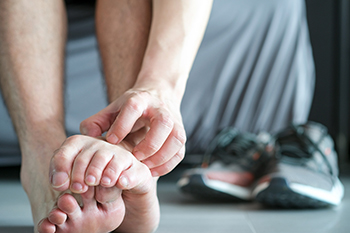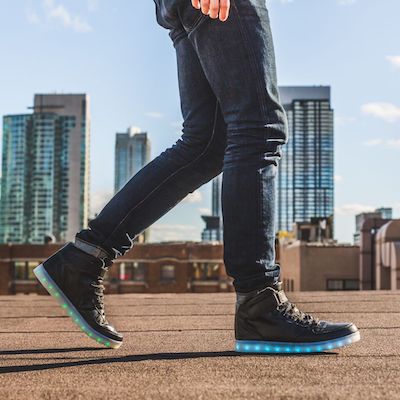Columbus: (614) 866-2477
Gahanna: (614) 939-9330
Lancaster: (740) 653-2656
Newark: (740) 344-8286
North Gahanna: (614) 478-2111
East Columbus: (614) 235-2323
Westerville: (614) 939-9330
Dublin: (614) 339-2000
Pickerington: (614) 545-4321
Lancaster: (740) 653-2656
Items filtered by date: February 2023
Fungus and Athlete’s Foot

An infection on the skin of the feet may be athlete’s foot. This condition is caused by different fungi and often affects the area between the toes. Common symptoms can include redness and itchiness, and the skin may begin to scale or flake. Tinea pedis is a type of fungus that often causes athlete’s foot. It lives and thrives in warm and moist environments, which can include public swimming pools and shower room floors. With good foot care routines, athlete’s foot may be prevented. Proper foot care may consist of trimming the toenails straight across but not too short, washing the feet daily, especially in between the toes, and avoiding walking barefoot. Since athlete’s foot is contagious it is beneficial to wear appropriate shoes while in communal areas and refrain from sharing shoes and towels. If you have symptoms of this uncomfortable condition, it is suggested that you consult with a podiatrist who can effectively diagnose and treat this ailment.
Athlete’s foot is an inconvenient condition that can be easily reduced with the proper treatment. If you have any concerns about your feet and ankles, contact one of our podiatrists from Foot & Ankle Specialists of Central Ohio. Our doctors will treat your foot and ankle needs.
Athlete’s Foot: The Sole Story
Athlete's foot, also known as tinea pedis, can be an extremely contagious foot infection. It is commonly contracted in public changing areas and bathrooms, dormitory style living quarters, around locker rooms and public swimming pools, or anywhere your feet often come into contact with other people.
Solutions to Combat Athlete’s Foot
- Hydrate your feet by using lotion
- Exfoliate
- Buff off nails
- Use of anti-fungal products
- Examine your feet and visit your doctor if any suspicious blisters or cuts develop
Athlete’s foot can cause many irritating symptoms such as dry and flaking skin, itching, and redness. Some more severe symptoms can include bleeding and cracked skin, intense itching and burning, and even pain when walking. In the worst cases, Athlete’s foot can cause blistering as well. Speak to your podiatrist for a better understanding of the different causes of Athlete’s foot, as well as help in determining which treatment options are best for you.
If you have any questions please feel free to contact our offices located in Gahanna, Newark, Columbus, and Lancaster, OH . We offer the newest diagnostic and treatment technologies for all your foot and ankle needs.
Obesity Negatively Affects the Feet

Studies have shown there is a negative relationship between body mass index, foot biomechanics, and the feet. In short, the heavier you are, the more likely you are to experience foot, heel, and ankle pain. Excess weight can also contribute to gout, osteoarthritis, plantar fasciitis, flat feet, and overpronation. It is commonly held that the feet can absorb from three to six times the weight of your body in force, such as walking, running, and jumping. A BMI over 30 doubles the risk of an ankle injury, but losing even five pounds can reduce the amount of pressure in the feet and ankles by 30 pounds. Some simple foot strengthening exercises such as scrunching up a towel with your toes can help reduce the effects of obesity. In addition, experts suggest wearing shoes that fit properly, provide ample arch support, and have adequate heel cushioning. And finally, a gradual weight loss regime can help to lighten the pressure on your feet. For more information on dealing with obesity and the resulting problems it may cause in the feet and ankles, please consult a podiatrist.
The more you weigh, the harder your feet must work to support your body. If you’re an obese individual and are concerned about your feet, contact one of our podiatrists from Foot & Ankle Specialists of Central Ohio. Our doctors can provide the care you need to keep you pain-free and on your feet.
Obesity and Your Feet
People who are overweight are putting more pressure on their ankles, knees, and hips as well as their feet. This unfortunately can lead to variety of different issues.
Problems & Complications Stemming from Obesity
- When the body is overweight, it tries to compensate by changing the way that it moves. An obese person may lean forward and put extra weight on the wrong part of the foot. This puts unnecessary stress on the feet.
- Obese people are also more likely to develop type II diabetes which is a condition that causes a lot of foot problems. People with diabetes often don’t feel the cuts and sores that they may have on their feet, which can lead to more complicated and severe issues.
- Plantar fasciitis is another foot condition that can be caused by obesity. Plantar fasciitis is an inflammation of the tissue along the bottom of the foot, which causes pain and stiffness while walking and climbing stairs.
If you have any questions, please feel free to contact our offices located in Gahanna, Newark, Columbus, and Lancaster, OH . We offer the newest diagnostic and treatment technologies for all your foot care needs.
Are You Suffering From Ingrown Toenails?
Foot Pain and Heart Disease

The feet are integral parts of the human body in their own right. However, the health of our feet can also tell us important things about our overall health and the health of other parts of our body. For example, the state of our feet can sometimes be an early warning sign for other health complications, such as heart disease. Specifically, pain in the muscles in the feet is sometimes associated with early signs of heart disease. This pain in the foot muscles might even travel up the calves and thighs. Besides foot pain, feelings of numbness in the feet when motionless might also indicate in some individuals a potential for experiencing heart disease. Additionally, swelling in the feet, which is also known as edema, can be associated with heart disease. If you are experiencing any of these symptoms and want to learn more about what they might mean, contact a podiatrist today for more information.
Foot Pain
Foot pain can be extremely painful and debilitating. If you have a foot pain, consult with one of our podiatrists from Foot & Ankle Specialists of Central Ohio. Our doctors will assess your condition and provide you with quality foot and ankle treatment.
Causes
Foot pain is a very broad condition that could be caused by one or more ailments. The most common include:
- Bunions
- Hammertoes
- Plantar Fasciitis
- Bone Spurs
- Corns
- Tarsal Tunnel Syndrome
- Ingrown Toenails
- Arthritis (such as Gout, Rheumatoid, and Osteoarthritis)
- Flat Feet
- Injury (from stress fractures, broken toe, foot, ankle, Achilles tendon ruptures, and sprains)
- And more
Diagnosis
To figure out the cause of foot pain, podiatrists utilize several different methods. This can range from simple visual inspections and sensation tests to X-rays and MRI scans. Prior medical history, family medical history, and any recent physical traumatic events will all be taken into consideration for a proper diagnosis.
Treatment
Treatment depends upon the cause of the foot pain. Whether it is resting, staying off the foot, or having surgery; podiatrists have a number of treatment options available for foot pain.
If you have any questions, please feel free to contact our offices located in Gahanna, Newark, Columbus, and Lancaster, OH . We offer the newest diagnostic and treatment technologies for all your foot care needs.
Turf Toe Pain in the Big Toe

Although the toes are relatively small parts of the human body, pain in these toes can be quite a significant annoyance. The big toe can be especially susceptible to pain. Turf toe in the big toe is one important potential source of pain in this toe. Turf toe is developed primarily from athletic physical activity when the big toe is constantly being bent upwards and downwards. Some of this bending can be awkward and the cause of pain. A case of turf toe can cause swelling in the big toe that might increase over time. Relatedly, the joint in the big toe might experience diminished mobility. If you are someone who regularly engages in physical, athletic activity and is concerned about protecting the health of your big toe, contact a podiatrist today.
Toe pain can disrupt your daily activities. If you have any concerns, contact one of our podiatrists of Foot & Ankle Specialists of Central Ohio. Our doctors can provide the care you need to keep you pain-free and on your feet.
What Causes Toe Pain?
Most severe toe pain is caused due to a sports injury, trauma from dropping something heavy on the toe, or bumping into something rigid. Other problems can develop over time for various reasons.
Toe pain can be caused by one or more ailments. The most common include:
- Trauma
- Sports injury
- Wearing shoes that are too tight
- Arthritis
- Gout
- Corns and calluses
- Hammertoe
- Bunions
- Blisters
- Ingrown toenails
- Sprains
- Fractures (broken bones)
- Dislocations
When to See a Podiatrist
- Severe pain
- Persistent pain that lasts more than a week
- Signs of infection
- Continued swelling
- Pain that prevents walking
Diagnosis
In many cases the cause of toe pain is obvious, but in others, a podiatrist may want to use more advanced methods to determine the problem. These can range from simple visual inspections and sensation tests to X-rays and MRI scans. Prior medical history, family medical history, and any recent physical traumatic events will all be taken into consideration for a proper diagnosis.
Treatment
Treatments for toe pain and injuries vary and may include shoe inserts, padding, taping, medicines, injections, and in some cases, surgery. If you believe that you have broken a toe, please see a podiatrist as soon as possible.
If you have any questions please feel free to contact our offices located in Gahanna, Newark, Columbus, and Lancaster, OH . We offer the newest diagnostic tools and technology to treat your foot and ankle needs.
What An Abnormal Gait Means for You
 For most, walking feels second-nature - carefree and easy to execute without having to put too much thought into it. But between strength, coordination, and balance, our body puts in a lot of work for each and every step. If your gait (how you walk) is abnormal or unusual, it could throw all three of those things off and cause multiple issues throughout your life.
For most, walking feels second-nature - carefree and easy to execute without having to put too much thought into it. But between strength, coordination, and balance, our body puts in a lot of work for each and every step. If your gait (how you walk) is abnormal or unusual, it could throw all three of those things off and cause multiple issues throughout your life.
What causes an abnormal gait?
An abnormal gait is something that anyone can experience. Here are ways it manifests at different points in peoples’ lives:
Children: Children grow and develop at different speeds, so spotting an abnormal gait can be tricky when they’re very young. Luckily, most common issues in children - like bow legs, flat feet, or in-toeing - right themselves as the child grows. However, if issues worsen, persist, or cause pain, it’s important to check in with a pediatric podiatrist.
Adults: Abnormal gait in adults can typically be attributed to a physical disability or an injury. If the abnormal gait is from a permanent disability, pain can be managed with walking aids, orthotics, and medication. If an injury has changed your gait, physical therapy can correct the issue over time.
Elderly: Degenerative diseases like arthritis, Parkinson’s, and dementia can bring about an abnormal gait or a lack of balance. Over 60% of people over 80 years old have some sort of gait abnormality. They can often be treated or improved through orthotics, physical therapy, and through walking aids.
What are the types of abnormal gaits?
There are different types of abnormal gaits that podiatrists look for, including:
- Limping gait: A very common abnormality that comes with a resistance to weight bearing on one side of the body.
- Scissors gait: A person’s legs bend in towards each other. They may even hit together when walking.
- Neuropathic gait: When a person’s toes point downwards or scrape along the ground as they walk.
- Diplegic gait: When a person drags their feet each step.
- Propulsive gait: The neck and head are permanently thrust forward in the body.
- Sensory or stomping gait: When someone picks their foot high off the ground and steps down hard with each step.
- Myopathic or waddling gait: When someone takes short steps and swings the body from side to side.
Get help from a foot care expert
If you are having issues with balancing properly, dealing with an injury that’s affecting the way you walk, or if you notice gait abnormalities in your child or another loved one, get in touch with our foot care specialists at Foot and Ankle Specialists of Central Ohio. Our expert podiatrists provide top notch foot and ankle care for the whole family to address acute and chronic issues, including heel pain, toenail fungus, bunions, arthritis, and diabetes. Contact any of our 9 locations in the Columbus, Ohio area to make an appointment today!
Blog Archives
- April 2024
- March 2024
- February 2024
- January 2024
- December 2023
- November 2023
- October 2023
- September 2023
- August 2023
- July 2023
- June 2023
- May 2023
- April 2023
- March 2023
- February 2023
- January 2023
- December 2022
- November 2022
- October 2022
- September 2022
- August 2022
- July 2022
- June 2022
- May 2022
- April 2022
- March 2022
- February 2022
- January 2022
- December 2021
- November 2021
- October 2021
- September 2021
- August 2021
- July 2021
- June 2021
- May 2021
- April 2021
- March 2021
- February 2021
- January 2021
- December 2020
- November 2020
- October 2020
- September 2020
- August 2020
- July 2020
- June 2020
- May 2020
- April 2020
- March 2020
- February 2020
- January 2020
- December 2019
- November 2019
- October 2019
- September 2019
- August 2019
- July 2019


